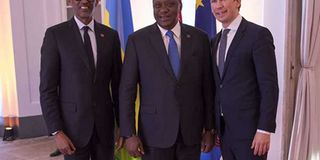Kenya and Rwanda ready for EU trade partnership deal

From left: Rwandan President Paul Kagame, President Uhuru Kenyatta and the Chancellor of Austria Sebastian Kurz in Vienna during the opening roundtable meeting of the High-Level Africa-Europe Forum Vienna 2018. Kenya says it will begin, together with Rwanda, implementing the economic partnership agreements with the EU despite other East African Community countries dragging their feet. PHOTO | PSCU
What you need to know:
- The matter came up early this week when President Kenyatta and Rwanda’s Paul Kagame met with senior EU officials in Vienna.
- Exports to the EU from EAC are mainly coffee, cut flowers, tea, tobacco, fish and vegetables.
- Under EPAs, EAC member states stand to gain duty-free access to the EU market for their produce.
Kenya says it will begin implementing the economic partnership agreements (EPAs) with the European Union (EU) despite other East African Community (EAC) countries dragging their feet.
The set of agreements commonly known as EPAs were supposed to be a joint negotiation between the East African countries and the EU and meant to open up markets while allowing the European bloc access into the EAC.
But after four years of haggling, only Kenya and Rwanda have signed the deal.
Kenyan diplomats now say they have agreed with Rwanda to move on with implementing the agreement without being entangled in the EAC fold.
UHURU, KAGAME MEET
The matter came up early this week when President Uhuru Kenyatta and Rwanda’s Paul Kagame met with senior EU officials in the Austrian capital of Vienna on the side-lines of the Africa-Europe High Level Forum.
On Thursday, the Ministry of Foreign Affairs issued a statement indicating president’s Kenyatta and Kagame had agreed with Jean-Claude Juncker, president of the European Union Commission and Antonio Tajani, president of the European Parliament, to start implementing the agreement.
“In particular, the leaders had unanimous consensus on the application of the principle of variable geometry as a mechanism of launching the implementation of EPA commitments for Kenya and Rwanda in their distinguished identity as the only EAC countries that have so far signed the EPA agreement,” Foreign Affairs Principal Secretary Macharia Kamau said in a statement.
VARIABLE GEOMETRY
Under the negotiations, the term “variable geometry” implies that while EAC was to negotiate as a bloc, both sides acknowledge that there may be differences, some irreconcilable, among the member states and that such should not delay implementation as long as there are mechanisms to iron them out.
As such, it allows one or more member states wishing to pursue a given goal to do so while allowing those opposed to hold back for a possible solution in the future.
Under EPAs, EAC member states stand to gain duty-free access to the EU market for their produce while partially and gradually allowing EU imports into their territory “taking full account of the differences in levels of development between the EAC and the EU”.
RELUCTANT
But while Kenya and Rwanda signed on the agreement, Uganda, Tanzania and Burundi have been reluctant to do so.
Tanzania had cited uncertainties relating to Brexit (given that UK was initially part of the EU) as well as a threat to nascent industries in the EAC.
Foreign Affairs Director of Economic Affairs Johnson Weru told the Nation that the decision to move ahead will not affect the integration momentum since it is only one aspect of the community.
“The clock was ticking and we had spent a significant amount of time negotiating. That is why it was agreed at the political level that we can proceed. It means we can now apply for the funds as provided for in Article 75 of the agreement,” the diplomat told the Nation.
“There is no threat on integration because variable geometry is an implementation tool and it will not be the first time it has been used in the EAC,” added the official, referring to the Northern Corridor Initiative where Kenya, Uganda, Rwanda and South Sudan have in the past agreed on joint infrastructure projects, as well as the admission to the EAC of Rwanda and Burundi, nearly ten years after the EAC Protocol was signed.
EPAS FUNDS
On Thursday, Kenya said it expects to legally access a portion of the € 40billion (Sh4.6 trillion) available under EPAs to develop priority areas listed in the set of agreements.
These include infrastructure, green energy, agriculture and market access, establishment of disease-free zones, blue economy, water resource management, technical and vocational training, training of farmers, customs/border management and private sector development.
EAC countries had jointly negotiated the EPAs until 2014 but some countries cited provisions which they argued could injure their local industries.
The EU had insisted the agreement will be valid only if all five EAC countries signed it and argued there is no threat on nascent industries because the agreements allowed either side to reintroduce safeguards against flooding of goods.
FLOWERS MARKET
Though Kenya could benefit more from the agreement by sustaining market for fresh flowers, the EU still sells more to the region than it buys from it.
In 2017, EU sold to EAC goods worth €3.6 billion (Sh417 billion) but bought goods worth €2.4 billion (Sh278 billion), leaving a balance of €1.2 billion (Sh139 billion).
Exports to the EU from EAC are mainly coffee, cut flowers, tea, tobacco, fish and vegetables.
Imports from the EU are mostly machinery and mechanical appliances, equipment and parts, vehicles and pharmaceutical products.
Kenya feels it is motivated to implement the agreement because it is the only country in the EAC which is considered above least developed countries, meaning it could suffer more were the EU to implement the tariffs.




